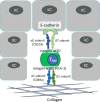Pathophysiology of Skin Resident Memory T Cells
- PMID: 33633737
- PMCID: PMC7901930
- DOI: 10.3389/fimmu.2020.618897
Pathophysiology of Skin Resident Memory T Cells
Abstract
Tissue resident memory T (TRM) cells reside in peripheral, non-lymphoid tissues such as the skin, where they act as alarm-sensor cells or cytotoxic cells. Physiologically, skin TRM cells persist for a long term and can be reactivated upon reinfection with the same antigen, thus serving as peripheral sentinels in the immune surveillance network. CD8+CD69+CD103+ TRM cells are the well-characterized subtype that develops in the epidermis. The local mediators such as interleukin (IL)-15 and transforming growth factor (TGF)-β are required for the formation of long-lived TRM cell population in skin. Skin TRM cells engage virus-infected cells, proliferate in situ in response to local antigens and do not migrate out of the epidermis. Secondary TRM cell populations are derived from pre-existing TRM cells and newly recruited TRM precursors from the circulation. In addition to microbial pathogens, topical application of chemical allergen to skin causes delayed-type hypersensitivity and amplifies the number of antigen-specific CD8+ TRM cells at challenged site. Skin TRM cells are also involved in the pathological conditions, including vitiligo, psoriasis, fixed drug eruption and cutaneous T-cell lymphoma (CTCL). The functions of these TRM cells seem to be different, depending on each pathology. Psoriasis plaques are seen in a recurrent manner especially at the originally affected sites. Upon stimulation of the skin of psoriasis patients, the CD8+CD103+CD49a- TRM cells in the epidermis seem to be reactivated and initiate IL-17A production. Meanwhile, autoreactive CD8+CD103+CD49a+ TRM cells secreting interferon-γ are present in lesional vitiligo skin. Fixed drug eruption is another disease where skin TRM cells evoke its characteristic clinical appearance upon administration of a causative drug. Intraepidermal CD8+ TRM cells with an effector-memory phenotype resident in the skin lesions of fixed drug eruption play a major contributing role in the development of localized tissue damage. CTCL develops primarily in the skin by a clonal expansion of a transformed TRM cells. CD8+ CTCL with the pagetoid epidermotropic histology is considered to originate from epidermal CD8+ TRM cells. This review will discuss the current understanding of skin TRM biology and their contribution to skin homeostasis and diseases.
Keywords: cutaneous T cell lymphoma; fixed drug eruption; psoriasis; resident memory T cell; skin; skin immunity; vitiligo.
Copyright © 2021 Tokura, Phadungsaksawasdi, Kurihara, Fujiyama and Honda.
Conflict of interest statement
The authors declare that the research was conducted in the absence of any commercial or financial relationships that could be construed as a potential conflict of interest.
Figures









Similar articles
-
CD49a Expression Defines Tissue-Resident CD8+ T Cells Poised for Cytotoxic Function in Human Skin.Immunity. 2017 Feb 21;46(2):287-300. doi: 10.1016/j.immuni.2017.01.009. Epub 2017 Feb 14. Immunity. 2017. PMID: 28214226 Free PMC article.
-
Tissue-resident memory T cells in the skin.Inflamm Res. 2020 Mar;69(3):245-254. doi: 10.1007/s00011-020-01320-6. Epub 2020 Jan 27. Inflamm Res. 2020. PMID: 31989191 Review.
-
Significance of IL-17A-producing CD8+CD103+ skin resident memory T cells in psoriasis lesion and their possible relationship to clinical course.J Dermatol Sci. 2019 Jul;95(1):21-27. doi: 10.1016/j.jdermsci.2019.06.002. Epub 2019 Jun 20. J Dermatol Sci. 2019. PMID: 31300254
-
The Emerging Role of CD8+ Tissue Resident Memory T (TRM) Cells in Antitumor Immunity: A Unique Functional Contribution of the CD103 Integrin.Front Immunol. 2018 Aug 15;9:1904. doi: 10.3389/fimmu.2018.01904. eCollection 2018. Front Immunol. 2018. PMID: 30158938 Free PMC article. Review.
-
Vitiligo Skin Is Imprinted with Resident Memory CD8 T Cells Expressing CXCR3.J Invest Dermatol. 2018 Feb;138(2):355-364. doi: 10.1016/j.jid.2017.08.038. Epub 2017 Sep 18. J Invest Dermatol. 2018. PMID: 28927891
Cited by
-
Lenvatinib or anti-VEGF in combination with anti-PD-1 differentially augments antitumor activity in melanoma.JCI Insight. 2023 Apr 10;8(7):e157347. doi: 10.1172/jci.insight.157347. JCI Insight. 2023. PMID: 36821392 Free PMC article.
-
The Immunology of Psoriasis-Current Concepts in Pathogenesis.Clin Rev Allergy Immunol. 2024 Apr;66(2):164-191. doi: 10.1007/s12016-024-08991-7. Epub 2024 Apr 20. Clin Rev Allergy Immunol. 2024. PMID: 38642273 Free PMC article. Review.
-
Targeting the IL-15/CD122 signaling pathway: reversing TRM cell-mediated immune memory in vitiligo.Front Immunol. 2025 Jul 28;16:1639732. doi: 10.3389/fimmu.2025.1639732. eCollection 2025. Front Immunol. 2025. PMID: 40791580 Free PMC article. Review.
-
Psoriasis de novo or exacerbation by PD-1 checkpoint inhibitors.An Bras Dermatol. 2024 May-Jun;99(3):425-432. doi: 10.1016/j.abd.2023.09.003. Epub 2024 Feb 21. An Bras Dermatol. 2024. PMID: 38388337 Free PMC article. Review.
-
Regulatory T Cells: Regulation of Identity and Function.Front Immunol. 2021 Oct 5;12:750542. doi: 10.3389/fimmu.2021.750542. eCollection 2021. Front Immunol. 2021. PMID: 34675933 Free PMC article. Review.
References
Publication types
MeSH terms
LinkOut - more resources
Full Text Sources
Other Literature Sources
Medical
Research Materials

